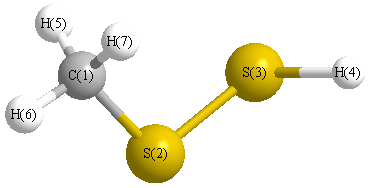Vibrational Frequencies calculated at TPSSh/cc-pVTZ
| Mode Number |
Symmetry |
Frequency
(cm-1) |
Scaled Frequency
(cm-1) |
IR Intensities
(km mol-1) |
Raman Act
(Å4/u) |
Dep P |
Dep U |
|---|
| 1 |
A |
3138 |
3039 |
7.86 |
57.17 |
0.75 |
0.86 |
| 2 |
A |
3121 |
3022 |
7.22 |
88.88 |
0.75 |
0.86 |
| 3 |
A |
3035 |
2939 |
18.41 |
185.01 |
0.03 |
0.05 |
| 4 |
A |
2620 |
2537 |
8.35 |
169.23 |
0.25 |
0.40 |
| 5 |
A |
1488 |
1441 |
7.59 |
7.42 |
0.74 |
0.85 |
| 6 |
A |
1468 |
1421 |
7.42 |
8.85 |
0.75 |
0.86 |
| 7 |
A |
1343 |
1300 |
4.91 |
0.92 |
0.52 |
0.69 |
| 8 |
A |
971 |
940 |
5.46 |
2.45 |
0.36 |
0.53 |
| 9 |
A |
967 |
936 |
3.08 |
1.97 |
0.60 |
0.75 |
| 10 |
A |
875 |
848 |
4.54 |
16.11 |
0.56 |
0.72 |
| 11 |
A |
684 |
662 |
1.68 |
12.90 |
0.25 |
0.40 |
| 12 |
A |
507 |
491 |
0.77 |
10.47 |
0.20 |
0.34 |
| 13 |
A |
341 |
330 |
13.34 |
6.30 |
0.75 |
0.86 |
| 14 |
A |
232 |
224 |
0.22 |
5.31 |
0.57 |
0.73 |
| 15 |
A |
160 |
155 |
0.42 |
0.02 |
0.66 |
0.80 |
Unscaled Zero Point Vibrational Energy (zpe) 10474.7 cm
-1
Scaled (by 0.9683) Zero Point Vibrational Energy (zpe) 10142.6 cm
-1
See section
III.C.1 List or set vibrational scaling factors
to change the scale factors used here.
See section
III.C.2
Calculate a vibrational scaling factor for a given set of molecules
to determine the least squares best scaling factor.
Charges, Dipole, Quadrupole and Polarizability
Charges from optimized geometry at TPSSh/cc-pVTZ
Charges (e)
| Number |
Element |
Mulliken |
CHELPG |
AIM |
ESP |
| 1 |
C |
-0.197 |
|
|
|
| 2 |
S |
-0.069 |
|
|
|
| 3 |
S |
-0.115 |
|
|
|
| 4 |
H |
0.092 |
|
|
|
| 5 |
H |
0.106 |
|
|
|
| 6 |
H |
0.087 |
|
|
|
| 7 |
H |
0.095 |
|
|
|
Electric dipole moments
Electric dipole components in Debye
(What's a Debye? See section
VII.A.3)
| |
x |
y |
z |
Total |
| |
-1.059 |
1.215 |
0.799 |
1.799 |
| CHELPG |
|
|
|
|
| AIM |
|
|
|
|
| ESP |
|
|
|
|
Electric Quadrupole moment
Quadrupole components in D Å
Polarizabilities
Components of the polarizability tensor.
Units are
Å
3 (Angstrom cubed)
Change units.
| |
x |
y |
z |
| x |
10.045 |
0.248 |
0.173 |
| y |
0.248 |
6.703 |
0.089 |
| z |
0.173 |
0.089 |
5.806 |
<r2> (average value of r
2) Å
2
| <r2> |
102.655 |
| (<r2>)1/2 |
10.132 |
